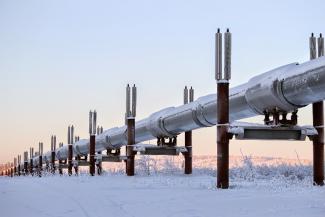Advanced sensors developed by NETL to detect and predict corrosion in natural gas pipelines can prevent ruptures and leaks that release methane — a potent greenhouse gas (GHG) — into the atmosphere and help mitigate climate change.
The nation’s natural gas pipeline network includes about 300,000 miles of major interstate and intrastate pipelines and more than 2 million miles of distribution lines. According to the U.S. Energy Information Administration, this vast transportation network delivered about 27.6 trillion cubic feet of natural gas to about 77.7 million consumers in 2021.
The primary component in natural gas is methane, the second most abundant anthropogenic GHG after carbon dioxide (CO2). Although its lifetime in the atmosphere is much shorter than CO2, methane is more than 25 times as potent as CO2 at trapping heat in the atmosphere.
“For the climate change and safety reasons, preventing leaks and ruptures anywhere along the natural gas pipeline network is a top NETL priority,” said the Ruishu Wright, a research scientist and technical portfolio lead for the NETL Natural Gas Infrastructure Field Work Proposal.
Work completed by Wright and Jagannath Devkota with former colleagues Ping Lu and Paul Ohodnicki has resulted in the development of a patented technology titled “Distributed Fiber-Optic Sensor Network for Sensing the Corrosion Onset and Quantification.” (US 11,726,047 B2, August 15, 2023)
Their invention combats corrosion in natural gas pipelines through early detection using either optical fiber-based or passive wireless sensing technology. The network is capable of monitoring internal corrosion in pipelines by obtaining precise localized multi-parameter measurements of condensed water properties.
According to the research team, the cost of rupture and leaks from natural gas pipelines totals $6 billion to $10 billion each year in the United States. “Therefore, a need exists to monitor corrosion inside gas pipelines to implement corrosion mitigation and control before any failure,” Wright said.
Additionally, Wright, Ohodnicki, Devkota and researchers Nathan Diemler and Nageswara Lalam filed in April for a non-provisional patent titled “Distributed Multi-Parameter Sensors for Simultaneous Monitoring of Corrosion and Humidity: Optical Fiber Sensors and Surface Acoustic Wave Sensors.” (U.S. Patent Application No. 18/302,209, April 18, 2023.)
NETL’s pipeline sensor team has completed successful field tests of an extensive new collection of fiber optic sensor and surface acoustic wave sensor technologies for natural gas pipeline monitoring that can help ensure safer and more secure natural gas pipeline delivery and mitigate methane emissions.
To increase the technology readiness level, the pipeline sensor team has focused on packaging the sensors and conducted field test validations at the Southwest Research Institute (SwRI) in San Antonio, Texas. Upcoming field tests with industry collaborators are planned.
Wright, who served as principal investigator on the project, explained that in the test, fiber optic sensors and surface acoustic wave sensors were installed outside and inside the natural gas-flowing multi-phase pipe test facility at SwRI. The test successfully monitored gas flow and leaks, internal water and corrosion, and pipeline conditions such as pressures and temperature changes.
The distributed fiber optic interrogation technology enables continuous, real-time measurements along the entire length of a fiber optic cable. The optical interrogator system connects to an optical fiber cable and injects laser in the form of short pulses into the fiber, converting it to an array of distributed sensors. The real-time data pinpoints the precise location of events and conditions occurring at or near the fiber sensor cable. Optical fiber sensors offer advantages over other types of sensors because they are small, lightweight, can endure high temperatures and pressures, and are immune to electromagnetic interference.
“These technologies can help operators learn about the precise location of potential pipeline safety threats and give the operator the opportunity to make timely responses,” Wright said.
NETL is a DOE national laboratory that drives innovation and delivers technological solutions for an environmentally sustainable and prosperous energy future. With its world-class talent and research facilities, NETL is ensuring affordable, abundant and reliable energy that drives a robust economy and national security, while developing technologies to manage carbon across the full life cycle, enabling environmental sustainability for all Americans.




